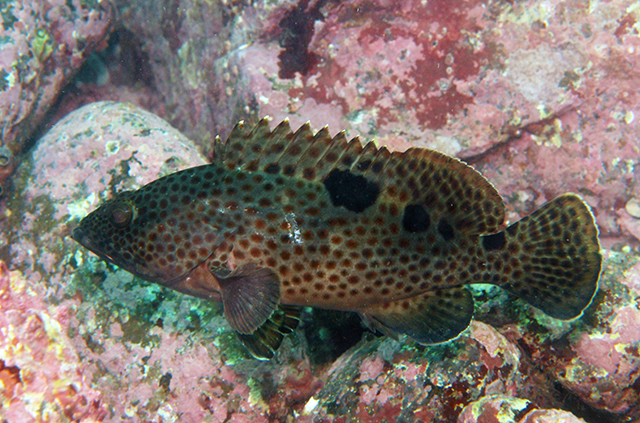| Epinephelidae (Groupers) |
| 50 cm TL (male/unsexed) |
|
reef-associated; marine; depth range 0 - 30 m |
| Northwest Pacific: southern Japan, Korea, Taiwan, and China. Reports of the species (under the valid name or as Epinephelus fario) from the Indian Ocean are apparently based on misidentifications. |
|
Dorsal spines (total): 11-11; Dorsal soft rays (total): 16-17; Anal spines: 3-3; Anal soft rays: 8-8. Preopercle rounded; serrae mostly hidden by skin; upper edge of operculum straight; nostrils small, subequal; maxilla reaches to or beyond vertical at rear edge of the eye. Area behind pectoral-fin tip with a patch of ctenoid scales in juveniles. Color is pale brown with small red or reddish brown spots. Fins darker, also covered with spots and often with a narrow white edge. A black blotch is at the base of the last 3 dorsal-fin spines, a smaller blotch at the base of the middle dorsal-fin rays, and a third on top of the caudal peduncle. Distinguished further by the following characteristics: body depth contained 2.7-3.3 times in SL; head length 2.4-2.6 times in SL; slightly convex interorbital area; small anterior and posterior nostrils, subequal; maxilla reaches to or past vertical at rear edge of eye; 2 rows of teeth on midlateral part of lower jaw (Ref. 89707). |
| Juveniles are common in tide pools and in shallow clear water around rocks and coral reefs; adults found in deeper water. Kuo et al. (1988, Ref. 6826) induced sex reversal and artificial spawning (referred to as 'Epinephelus fario'). |
|
Least Concern (LC); Date assessed: 25 November 2016 Ref. (130435)
|
| harmless |
Source and more info: www.fishbase.org. For personal, classroom, and other internal use only. Not for publication.

